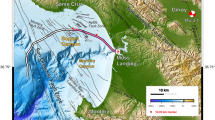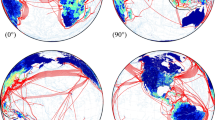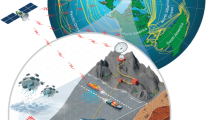Abstract
In order to improve the locating capability for offshore earthquakes and tsunamis monitored off northeastern Taiwan, a cable-based ocean bottom seismographic observatory named “Marine Cable Hosted Observatory” (MACHO) was constructed and began operation at the end of 2011. The installed instruments of the observatory include a broadband seismometer, a strong-motion seismometer and a pressure gauge. In addition, various scientific instruments could be deployed for other purposes as well. At present, the seismic data are transmitted in real-time via a fiber cable, and integrated into the current inland seismographic network in Taiwan. The ocean bottom station has contributed to provide high quality seismic data already. According to observations from January 2012 to June 2013, there were a total of 15,168 earthquakes recorded by the system. By using the data from the ocean bottom station, the number of relocated earthquakes with an azimuth gap less than 180 degrees substantially increase about 34 %. Meanwhile, the root–mean–square of the time residual, the error in epicenter, and the error in depth of the earthquake locations decrease. Therefore, the implementation of MACHO has the advantage of extending the coverage of existing the Taiwan seismic network to the offshore, providing more accurate and real-time seismic data for offshore earthquakes monitoring. The results show that MACHO is crucial and necessary for monitoring seismic activities in northeastern Taiwan.











Similar content being viewed by others
References
Campos J, Hatzfeld D, Madariaga R, Lopez G, Kausel E, Zollo A, Iannacone G, Fromm R, Barrientos S, Lyon-Caen H (2002) A seismological study of the 1835 seismic gap in south-central Chile. Phys Earth Planet Inter 132:177–195
Chan CH, Wu YM, Tseng TL, Lin TL, Chen CC (2012) Spatial and temporal evolution of b-values before large earthquakes in Taiwan. Tectonophysics 532:215–222. doi:10.1016/j.tecto.2012.02.004
Chiang HT, Shyu CT, Chang HI, Tsao S, Chen CX (2010) Geothermal monitoring of Kueishantao island offshore of northeastern Taiwan. Terr Atmos Ocean Sci 21:563–573. doi:10.3319/TAO.2009.11.02.01(TH)
Clift PD, Lin ATS, Carter A, Wu F, Draut AE, Lai TH, Fei LY, Schouten H, Teng L (2008) Post-collisional collapse in the wake of migrating arc-continent collision in the Ilan Basin, Taiwan. Formation and Applications of the Sedimentary Record in Arc Collision Zones. Geol Soc Am Spec Pap 436:257–278
Hsiao NC, Wu YM, Zhao L, Chen DY, Huang WT, Kuo KH, Shin TC, Leu PL (2011) A new prototype system for earthquake early warning in Taiwan. Soil Dyn Earthq Eng. doi:10.1016/j.soildyn.2010.01.008
Hsu SK, Sibuet JC (2005) Earthquake off Japan could generate strong tsunami arrays. Eos Trans AGU 86(17):169. doi:10.1029/2005EO170003
Hsu YJ, Ando M, Yu SB, Simons M (2012) The potential for a great earthquake along the southernmost Ryukyu subduction zone. Geophys Res Lett 39:L14302. doi:10.1029/2012GL052764
Hsu SK, Yeh YC, Sibuet JC, Doo WB, Tsai CH (2013) A mega-splay fault system and tsunami hazard in the southern Ryukyu subduction zone. Earth Planet Sci Lett 362:99–107
Lin JY, Hsu SK, Sibuet JC (2004) Melting features along the western Ryukyu slab edge (northeast Taiwan): tomographic evidence. J Geophys Res 109:B12402. doi:10.1029/2004JB003260
Lin CH, Hsu LW, Ho MY, Shin TC, Chen KJ, Yeh YH (2007) Low-frequency submarine volcanic swarms at the southwestern end of the Okinawa Trough. Geophys Res Lett 34:L06310. doi:10.1029/2006GL029207
Liu CS, Liu SY, Lallemand SE, Lundberg N, Reed D (1998) Digital elevation model offshore Taiwan and its tectonic implication. Terre Atmos Ocean Sci 9:705–738
Moreno M, Rosenau M, Oncken O (2010) Maule earthquake slip correlates with pre-seismic locking of Andean subduction zone. Nature 467:198–204
Ruegg JC, Rudloff A, Vigny C, Madariaga R, Chabalier JB, Campos C, Kausel E, Barrientos S, Dimitrov D (2009) Interseismic strain accumulation measured by GPS in the seismic gap between constitución and concepción. Phys Earth Planet Inter 175:78–85
Seno T, Stein S, Gripp AE (1993) A model for the motion of the Philippine sea plate consistent with NUVEL-1 and geological data. J Geophys Res 98(B10):17,941–17,948. doi:10.1029/93JB00782
Theunissen T, Font Y, Lallemand S, Liang WT (2010) The largest instrumentally recorded earthquake in Taiwan: revised location and magnitude, and tectonic significance of the 1920 event. Geophys J Int 183:1119–1133. doi:10.1111/j.1365-246X.2010.04813.x
Tsai YB, Teng TL, Chiu JM, Liu HK (1977) Tectonic implications of the seismicity in the Taiwan region. Mem Geol Soc China 2:13–41
Wang JH, Kuo HC (1995) A catalogue of M ≥ 7 Taiwan earthquakes (1900–1994). J Geol Soc China 38(2):95–106
Wiemer S, Wyss M (2000) Minimum magnitude of complete reporting in earthquake catalogs: examples from Alaska, the Western United States, and Japan. Bull Seismol Soc Am 90:859–869
Wu YM, Chang CH, Kuo-Chen H, Hunag HH, Wang CY (2013) On the use of explosion records for examining earthquake location uncertainty in Taiwan. Terr Atmos Ocean Sci. doi: 10.3319/TAO.2013.01.31.01(T)
Yu SB, Chen HY, Kuo LC (1997) Velocity field of GPS stations in the Taiwan area. Tectonophysics 274:41–59. doi:10.1016/S0040-1951(96)00297-1
Acknowledgments
We would like to express our gratefulness to the consultative committee of the MACHO project. The representative members include Prof. C.-S. Lee (National Taiwan Ocean University), Prof. C.-S. Liu, Prof. C.-F Chen (National Taiwan University), Dr. B.-Y. Kuo, Dr. C.-H. Lin, Dr. B.-S, Huang (Academia Sinica), Prof. C.-C. Wang (National Sun Yat-Sen University), and David Guan (Chunghwa Telecom). Due to their directions and comments proposed, the submarine system has finally built and begun in operation already. Dr. Y. Kaneda from the JAMSTEC (Japan Agency for Marine-Earth Science and Technology) is also acknowledged for providing the recent information on the developments of marine cable systems in Japan. Meanwhile, we want to thank Dr. C.-W. Kan and Dr. H.-C. Pu to help arranging the seismic data of this article. Reviews of this manuscript by Editor in Chief Dr. Amy Draut and three reviewers provided numerous constructive comments and had the paper much improved. The MACHO project was supported by the National Science Council and the Central Weather Bureau in Taiwan.
Author information
Authors and Affiliations
Corresponding author
Rights and permissions
About this article
Cite this article
Hsiao, NC., Lin, TW., Hsu, SK. et al. Improvement of earthquake locations with the Marine Cable Hosted Observatory (MACHO) offshore NE Taiwan. Mar Geophys Res 35, 327–336 (2014). https://doi.org/10.1007/s11001-013-9207-3
Received:
Accepted:
Published:
Issue Date:
DOI: https://doi.org/10.1007/s11001-013-9207-3




